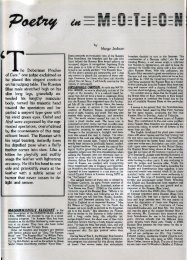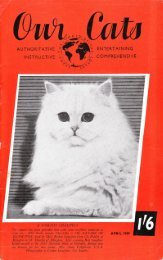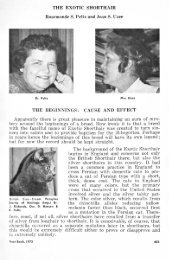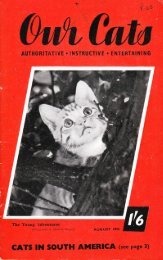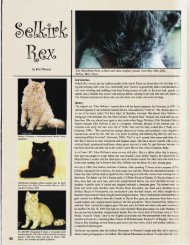Mrs. Norah Andrews - Kyina & Talisker Cats Breeders of Russian ...
Mrs. Norah Andrews - Kyina & Talisker Cats Breeders of Russian ...
Mrs. Norah Andrews - Kyina & Talisker Cats Breeders of Russian ...
You also want an ePaper? Increase the reach of your titles
YUMPU automatically turns print PDFs into web optimized ePapers that Google loves.
Eezentu - the Cornrnon SeaurgeEttracts from a paper rearl b7 'tl:t recen.t Tlst Annu.al Congress oJ[r. S'. Jennings, M.R.C.V.S., atthe British Veterinar2 Association.\ the majoritl- <strong>of</strong> papers on1I animal skin diseases that haver b..n published in the pasr 25r ears the writers appear to havegir"en their general impressions <strong>of</strong>skin conditions as gained in thecourse <strong>of</strong> practice but r,l'ithoutleference to figures based onindividrral records. In the preserrrpaper, therefore, an attempt hasbeen made to confine the obserr-ationsto those made on a series <strong>of</strong>carefully recorded cases. Theu.ork was carried out a feu' vearsaqo. and though many skin caseshad been seen prior to the presentseries, and from which generalimpressions had been gained. aspecial effort has been made toavoid using such unrecorded data.The British Veterinary Associationmade the request that thepaper should be confined to skindiseases <strong>of</strong> small animals and,while this has been fulfilled, noattempt has been made to presenta comprehensive survey <strong>of</strong> all skindiseases <strong>of</strong> small animals and onlvthose facts rvhich it is believedhave not been published hithertoare included.So many attempts have beenmade by dermatologists to defineeczelrna and so many conditionshave been laltelled as eczema thatit has now virtually become a termn'hich is used to describe anyinflammation <strong>of</strong> the skin thecause or nature <strong>of</strong> which is unkrrown.Most users <strong>of</strong> the [erm,however, feel that it is associatedrrith some antigen-cellular-antibodr.reaction and some workershave norn' come to use the term"atopic dermatitis" and "allergicdermatitis" in its place. ButCooke (1947) states that " in noimportant group <strong>of</strong> commonlyaccepted diseases <strong>of</strong> allergy is ourknowledge more scanty and moresuperficial, and the dermatologicand allergic literature more contradictirrgand confusing than intl-rat group designated as allergicdermatitis." The term eczerna,therefore, does not necessarily giveanv indication as to the aetiologyrut" conditions bearing this::*:.ti.-^^^ tl"o .,,. ^^-, . -,,.,non<strong>of</strong> cats, has a clinical scourgepictureclosely resembling that <strong>of</strong> eczemain the dog. Seventy-seven caseswere seen in the present series.Holmes (1933) suggested that the]esions are self-inflicted and producedby the rough tongue <strong>of</strong> thecat. Records <strong>of</strong> the positions <strong>of</strong>the lesions show that almost invariablythe lesions were within reach<strong>of</strong> the animal's tongue. The catis able to bend the neck so that itcan lick the skin over the spinalcolumn just behind the scapula.By lf ing and then lifting one hindleg until it points directly upwardsthe cat can reach the whole <strong>of</strong>theposterior aspect <strong>of</strong> the thigh. Themajority <strong>of</strong> lesions were in thatpart <strong>of</strong> the leg and on the skin ateither side <strong>of</strong> the spinal columnlrom the scapula backwards. Infour cases there were alsoIesions on the head and in twothere were lesions on the dorsalaspect <strong>of</strong> the neck. Scratchingwith the hind ieg could haveaccounted for these, however.




